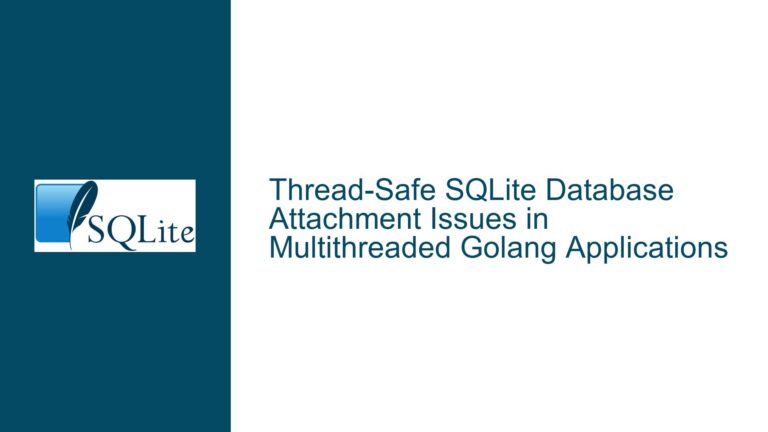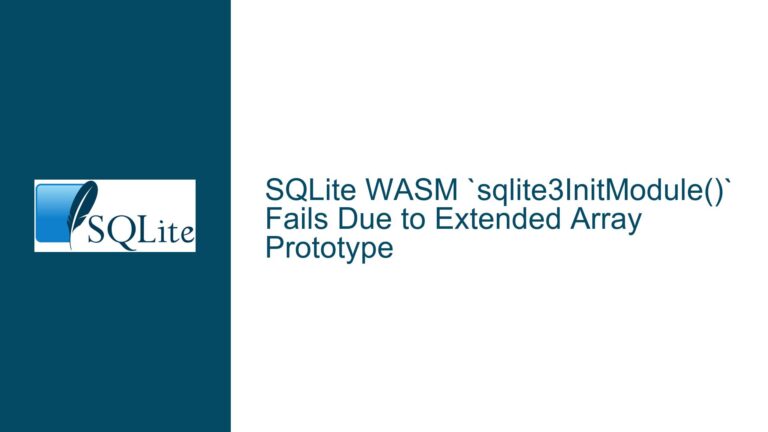Handling NULL xSize in SQLite3 Custom Allocators and Avoiding Memory Alignment Pitfalls
Memory Allocation Override Limitations in SQLite3 and Alignment Risks
Core Challenge: Implementing Custom Memory Methods Without xSize Support
SQLite3 allows developers to override default memory allocation routines by defining a custom sqlite3_mem_methods structure. This structure includes function pointers for xMalloc, xFree, xRealloc, and xSize. The xSize method is intended to return the size of a memory block previously allocated by xMalloc or xRealloc. However, certain platforms (e.g., embedded systems, legacy environments) lack native support for determining the size of dynamically allocated memory blocks. This creates a conflict: SQLite3 expects xSize to be a valid function pointer, but developers working on such platforms cannot provide a meaningful implementation for it. Attempting to set xSize to NULL in the sqlite3_mem_methods struct results in errors or undefined behavior, as SQLite3 assumes this method is always available for internal bookkeeping.
The problem is compounded when developers attempt workarounds, such as wrapping system memory functions to manually track block sizes. These wrappers often prepend size metadata to allocated blocks. While functional in theory, this approach introduces risks related to memory alignment. For example, inserting a 4-byte integer to store the block size before the returned pointer may violate alignment requirements for SIMD instructions (e.g., SSE on x86) or strict alignment architectures (e.g., SPARC, ARMv5). Misaligned memory accesses can trigger fatal hardware exceptions (e.g., SIGBUS on Unix-like systems) or degrade performance due to unaligned load/store penalties.
Root Causes of xSize Constraints and Alignment Failures
Three primary factors contribute to this issue:
SQLite3’s Reliance on xSize for Memory Management
SQLite3 usesxSizeto validate memory operations, optimize reallocations, and enforce internal consistency checks. For example, when resizing a block viaxRealloc, SQLite3 may callxSizeto verify the original block’s size before proceeding. IfxSizeisNULL, these checks are bypassed, potentially leading to heap corruption or silent data truncation. The engine’s internal logic assumes that all custom allocators provide a mechanism to query block sizes, makingxSizenon-optional in the current design.Platform-Specific Absence of
msize()-Like Functions
Some C standard library implementations (e.g., minimalist embedded libc variants) omitmsize()or equivalent functions that return the usable size of a heap block. This forces developers to implement size-tracking manually. However, manual tracking requires altering the memory layout of allocated blocks, which introduces alignment challenges if not done carefully.Alignment Violations in Manual Size Tracking
A common workaround involves prepending the block size as metadata to the allocated memory. For instance:void* my_malloc(int size) { int* header = system_malloc(size + sizeof(int)); *header = size; return header + 1; // Return pointer after the metadata }This code shifts the returned pointer by
sizeof(int)bytes, which may misalign the memory region intended for the application. If the system mandates 16-byte alignment for certain data types or instructions (e.g.,__m128in SSE), the shifted pointer might land on an unaligned address (e.g., 4 + N*16 + 12 = 16-byte unaligned). Subsequent accesses to this region via aligned operations will crash.
Resolving xSize Dependency and Ensuring Memory Alignment
Step 1: Validate SQLite3’s xSize Requirements
Before proceeding, confirm whether your SQLite3 build strictly requires xSize. Compile SQLite3 with the SQLITE_DEBUG flag and run your application. If assertions related to memory management fail (e.g., sqlite3MallocSize() returning zero), this indicates that xSize is mandatory for your use case. If you cannot modify SQLite3’s source code, proceed to implement a compliant xSize workaround.
Step 2: Implement Size Tracking with Alignment Guarantees
Modify your custom allocators to ensure metadata storage does not violate alignment. Instead of naively prepending a 4-byte integer, use a padding strategy that respects the platform’s maximum alignment requirement. For example:
// Determine maximum alignment (e.g., 16 for SSE)
#define MAX_ALIGNMENT 16
typedef struct {
size_t size;
char padding[MAX_ALIGNMENT - (sizeof(size_t) % MAX_ALIGNMENT)];
} Metadata;
void* my_malloc(int size) {
if (size == 0) return NULL;
// Allocate space for metadata + requested size, aligned to MAX_ALIGNMENT
void* block = system_malloc(sizeof(Metadata) + size + MAX_ALIGNMENT);
if (!block) return NULL;
// Align the metadata to MAX_ALIGNMENT
uintptr_t addr = (uintptr_t)block;
addr = (addr + MAX_ALIGNMENT - 1) & ~(MAX_ALIGNMENT - 1);
Metadata* metadata = (Metadata*)(addr - sizeof(Metadata));
metadata->size = size;
return (void*)addr;
}
size_t my_size(void* ptr) {
if (!ptr) return 0;
Metadata* metadata = (Metadata*)((uintptr_t)ptr - sizeof(Metadata));
return metadata->size;
}
void my_free(void* ptr) {
if (!ptr) return;
Metadata* metadata = (Metadata*)((uintptr_t)ptr - sizeof(Metadata));
// Calculate original block address, accounting for alignment padding
void* original_block = (void*)((uintptr_t)metadata - (metadata->padding));
system_free(original_block);
}
This approach ensures that the metadata header (size + padding) and the returned pointer adhere to the platform’s alignment constraints. The padding field absorbs any offset introduced during alignment correction.
Step 3: Test for Architecture-Specific Edge Cases
Cross-compile your application for the target platform and run alignment-sensitive workloads. For x86_64 systems, test with SSE/AVX-enabled code. On ARM, test with Thumb-2 or NEON instructions. Use debuggers or sanitizers (e.g., AddressSanitizer’s alignment checks) to detect unaligned accesses. If crashes persist, increase MAX_ALIGNMENT to match the platform’s worst-case requirement (e.g., 32 bytes for AVX-256).
Step 4: Patch SQLite3 to Tolerate NULL xSize (Advanced)
If you control the SQLite3 build, modify the engine to bypass xSize when it is NULL. In src/mem.c, locate calls to sqlite3MallocSize() and add fallback logic:
#ifndef SQLITE_OMIT_MEMORY_SIZE
if( sqlite3GlobalConfig.m.xSize ){
return sqlite3GlobalConfig.m.xSize(p);
} else {
// Return 0 or a default size if xSize is unavailable
return 0;
}
#else
return 0;
#endif
Recompile SQLite3 with -DSQLITE_OMIT_MEMORY_SIZE to disable all xSize dependencies. Warning: This may degrade performance or stability, as SQLite3 relies on xSize for sanity checks during reallocations and shutdown.
This guide provides a comprehensive pathway to address SQLite3’s xSize constraints while safeguarding against alignment-related crashes. By combining manual size tracking with alignment-aware metadata storage, developers can override memory methods safely, even on platforms lacking native msize() support.






